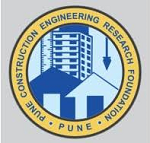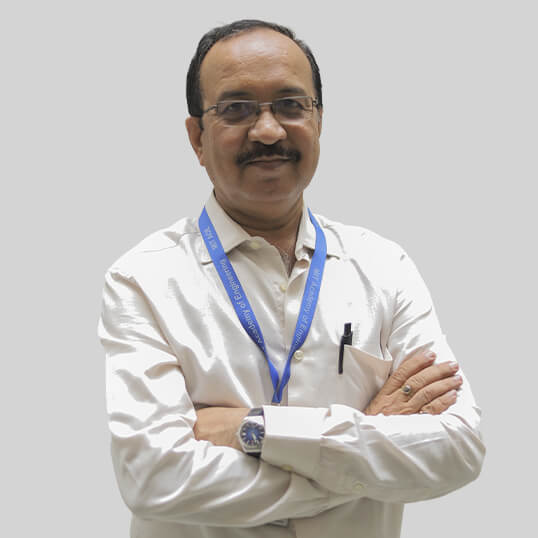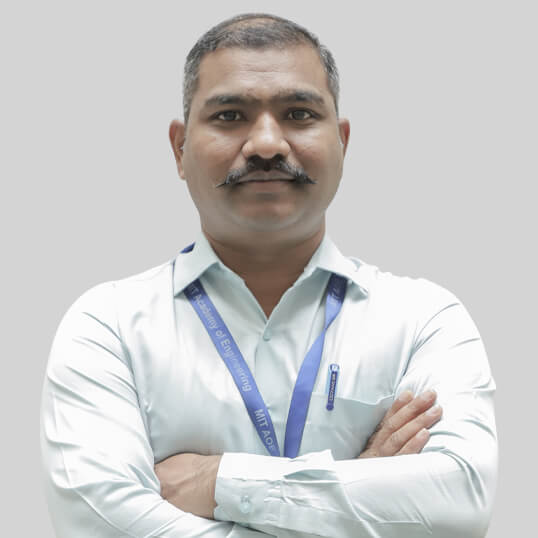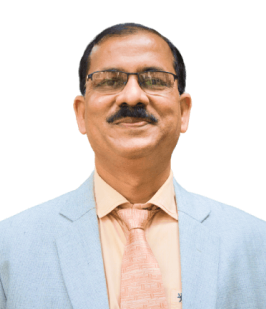Program Overview
The Department of Civil Engineering, established in 2014-15 with an intake of 60 students, offers a comprehensive curriculum inspired by international standards, combining theoretical courses with hands-on laboratory experimentation. Students gain industrial exposure through various internship programs and are encouraged to undertake independent projects and seminars fostering creative thinking and problem-solving skills. Accredited by the NBA Tier-I in 2023, the Department is renowned for student-centric activities such as seminars, workshops, guest lectures and industrial visits that bridge the gap between academics and industry needs. Graduates are well-placed globally, with many pursuing higher studies in prestigious institutions.
- B. Tech Civil Engineering
- Intake 60 | NRI 5%
-
Program Duration 4 Years
- Semesters 8 Semesters
- Weekly hours 40 Hours
- Total Credits 163
Vision Mission
Vision
To be a state-of-the-art Department of Civil Engineering dedicated to the holistic development of students by imparting knowledge for ever-changing industrial, ecological & social needs.
Mission
- Providing state-of-the-art infrastructure facilities combined with skill-based education and outcome-based pedagogical practices in order to build competent engineering professionals who can address real-world challenges in civil engineering.
- Nurturing students for professional growth by transforming civil engineering educational practices, focusing on research aptitude.
- Imbibing students for humanitarian efforts in order to elevate moral and ethical responsibilities for society.
- Enhancing entrepreneurial and managerial skills by developing industry-institute relations.
Program Electives Open Electives
- Construction Management
- Environmental and Water Resource Engineering
Multi-Disciplinary (Minors)
- Broaden their career opportunities
- Gain interdisciplinary knowledge and skills
- Enhance their problem-solving capabilities
- Infrastructure and Sustainability
Program curriculum
Semester - 1
- Calculus and Differential Equations
- Engineering Physics
- Electrical and Electronics Engineering
- Foundations of Computing
- Computer-Aided Engineering Drawing
- Communication Skills (English/ German/Japanese/ French)
- Liberal Learning
- Indian Knowledge System (Ancient Indian Architecture and Town Planning)
Semester II
- Statistics and Integral Calculus
- Science of Nature
- Applied Mechanics
- Design Thinking
- Surveying and Geomatics
- Basics of Civil Engineering
- Creative Technologies
Semester III
- Mechanics of Solids
- Geotechnical Engineering
- Building Design and Construction
- Building Information Modeling-I
- Prototyping
- Entrepreneurship Skills
- Universal Human Values
- Minor Project Design
- Internship (Life And Soft Skills)
Semester IV
- Mechanics of Fluids
- Surveying and Geospatial Engineering
- Structural Analysis
- Applied Mathematics
- Data Analysis
- Environmental Science
- Project Implementation
- Indian Constitution
- Engineering Informatics
Semester V
- Concrete Technology
- Water supply and Sanitation Engineering
- Construction Engineering & Management/ Hydrology and Irrigation Engineering/ Design of Steel Structures
- Smart Cities
- Analysis & Design of Building Systems/ Building Information Modeling-II
- Project – I
- Internship (Technical)
Semester VI
- Design of Reinforced Concrete Structures
- Transportation Engineering
- Contracts Management / Solid and Industrial Waste Management / Formwork Design
- Drone Surveying/ Hydraulic Modeling
- Sustainable Engineering
- Employability and Career Development
- Project – II
Semester VII
- Estimating and Costing
- Building Services/ Railway Engineering
- Financial Management/ Environmental Impact assessment and Climate Change
- Skill Development Course – 4(Computational Fluid Dynamics (CFD) / Quantum Geographic Information System(QGIS))
- Project Evaluation
- Summer Internship
Semester VIII
- Design of Hydraulic Structures
- Engineering Economics
- Psychology
- Capstone Work
- SWAYAM NPTEL
OR
- Design of Hydraulic Structures
- Semester Long Internship Design
- Semester Long Internship Implementation
- SWAYAM NPTEL
Career Opportunities
- Structural Engineering
- Geotechnical Engineering
- Transportation Engineering
- Environmental Engineering
- Construction Management
- Water Resources Engineering
- Urban and Regional Planning
- Offshore and Marine Engineering
- Surveying and Mapping
- Academia and Research
POs, PSOs, PEOs
View Details
UG - Civil
View UG - Civil Details
Program Fees
Download Regular Seats Fee Structure
Fee Details
- Tution Fees Rs. 1,66,087/- per year
- Development Fees Rs. 24,913/- per year
- University Fees Rs. 737/- per year
- Management Seat Fees 1,91,737/- per year
- NRI Seat Fees Rs. 3,82,737/- per year
- Against NRI Seat Fees Rs. 1,91,737/- per year
- Caution Money / Refundable Deposit Rs. 25,000/- One Time
Fees (for AY 2025-26)
- Open Category Rs. 1,91,737/- per year
- OBC/EBC/EWS/SEBC (Male Student) Rs. 1,08,694/- per year
- OBC/EBC/EWS/SEBC (Female Student) Rs. 25,650/- per year
- SC/ST/NT/SBC/TFWS 25,650/- per year
- J and K Rs. 24,737/- per year
Admission Process
Candidates are advised to follow the process for admission to First Year Engineering courses as published by the Directorate of Technical Education, Maharashtra State from time to time
Refundable Caution Money Deposit
As per the FRA norms the student is supposed to pay the refundable caution
money of Rs. 25,000/- for the following courses at the time of admission of the
first year students.
Name of the Course
Bachelor of Engineering (B. Tech Program) 25,000/-
Bachelor of Design (B. Des Program) 25,000/-
Master of Engineering (M. Tech Program) 25,000/-
** The caution money collected shall be refunded to the students within 90 days of the completion of the course on presentation of the receipt and other related documents.
Name of the Course
Bachelor of Engineering (B. Tech Program) 25,000/-
Bachelor of Design (B. Des Program) 25,000/-
Master of Engineering (M. Tech Program) 25,000/-
** The caution money collected shall be refunded to the students within 90 days of the completion of the course on presentation of the receipt and other related documents.
Board of Studies
View BoS Details
Accreditations
MITAOE is consistently ranked among the top engineering institutes, recognized for its academic excellence and innovative research. Our programs are accredited by national bodies, ensuring high standards in education and fostering industry-ready graduates. We prioritize quality education, enabling students to thrive in a rapidly evolving global landscape.

NAAC Accreditation
The institute is assessed and accredited with "A" grade by the National Assessment and Accreditation Council (NAAC) in cycle 2 from 23 November 2023 to 22 November 2028.
ISO Certified
MITAOE has now implemented the Educational Organizations Management System (EOMS) in accordance with ISO 21001:2018, further strengthening its dedication to excellence in education and institutional effectiveness

NBA Accreditation
Electronics & Telecommunication Engineering, Chemical Engineering, Computer Engineering and Mechanical Engineering, Civil Engineering accredited by National Board of Accreditation in Tier-I mode

Affiliated to SPPU
MIT Academy of Engineering Affiliated to Savitribai Phule Pune University(SPPU).

NIRF Institute Ranking
Ranking - To check the position of institute amongst others and to test quality; every year we participate in various ranking systems and surveys like NIRF, India Today Ranking, Swacch Campus Ranking, AICTE-CII Survey of Industry Linked Technical Institutes, and Atal Ranking of Institutions on Innovation Acheivements.
Civil Engineering Faculty
View More Faculty
More Faculties
Laboratories
View Laboratories Details
Industry Collaborations

Conchem Labs LLP

Water Field Technologies Pvt Ltd.
Thane West, Thane, Maharashtra 400607

DASOFF Petroleum Services LLC
Abu Dhabi - United Arab Emirates

SoftTech Engineers Limited
Pune

Siddhi Consulting Engineers Pvt Ltd
Pune

The Ampar Group
Pune

Pune Construction Engineering Research Foundation
Pune

Arete Allied

Innovetia Consulting Engineers India Pvt. Ltd.
Placements & Industry Exposure
64% Students
Total Placements in AY 2022-23
60% Students
Total Placements in AY 2023-24
18.5% Students On Going
Total Placements in AY 2024-25
6.5 LPA
Highest Package AY 2024-25
2.5 LPA
Average Package AY 2024-25
Internships
Students gain industrial exposure through various internship programs which are as follow:
Summer Internship Program (SIP): Students compulsorily need to undergo SIP after completing their semester VI.
Semester Long Internship Program (SLIP): Selected students undergo SLIP during their semester VIII.
During these internship programs, students are getting internships in renowned industries like Zamil Steel INDIA LTD, Panchshil Realty, Durocrete ete, Prime City, CQRA PVT. LTD.,SCG Design Solutions, Mantra Properties.
Student Testimonials
At MITAOE, students acquire technical expertise alongside vital life skills. With continuous faculty support, industry exposure, and practical learning experiences, their careers are shaped for success. Students are eager to be part of an institute that fosters innovation, collaboration, and overall personal and professional development.
Newsletters
View Newsletters Details
Get in Touch
Education for the Next Generation to Built a Better World !!
Frequently Asked Questions
Getting ready to apply? Check out the Admissions FAQ for answers to your questions on application requirements, deadlines, cost of attendance, residency, and more.
View All
1. What programs does the MIT Academy of Engineering offer?
The MIT Academy of Engineering provides undergraduate and graduate degrees in a variety of engineering disciplines, including computer engineering, electronics and telecommunications engineering, mechanical engineering, civil engineering, and information technology.
2. Is the MIT Academy of Engineering a private college?
MIT Academic of Engineering is an Empowered Autonomous Engineering college, affiliated with Savitribai Phule Pune University.
3. Is the MIT Academy of Engineering linked with any university?
Yes, the MIT Academy of Engineering is associated with Savitribai Phule Pune University.
4. What are the eligibility requirements for undergraduate engineering programs?
Students must have finished 10+2 or equivalent with Physics, Chemistry, and Mathematics and have a valid score on entrance exams such as JEE Main or MHT-CET.
5. How can I apply for admission to the MIT Academy of Engineering?
During the admissions cycle, you can apply online via the official website. The admissions page includes detailed instructions and forms. And also you have to fill the CET application form for getting admission in any engineering college.
6. Which entrance examinations are acceptable for Engineering admission?
The MIT Academy of Engineering accepts JEE Main, MHT-CET.
7. When does the admission process begin?
Admissions normally begin in June after entrance exam results are announced.
8. What is the placement rate at the MIT Academy of Engineering?
The MIT Academy of Engineering has a strong placement record, with a significant percentage of students finding jobs before graduating.
9. Are internships mandatory for students?
Yes, internships are required as part of the program to gain practical experience and exposure to the industry.
10. How does the college help students secure internships?
The college has a specialized placement and internship unit that helps students find internships through industry ties and cooperation. 5-6. Months internship is compulsory, as a part of academics.
An interesting part is that MITAOE is providing internships on International level. Having MoUs signed with universities abroad we scan and send third year students to have global experience.





















